The Earth is composed of a central core, a mantle, and a surface crust. The Earth’s physical structure is in a constant state of flux due to internal dynamic processes.
In contrast to the rocks found on the Earth’s surface, the rocks closer to the Earth’s core experience such extreme temperatures and pressures that they can become plastic and exhibit slow flow, despite being in a solid state.
Composition of the Earth’s Core and the Processes Occurring Within
In the early stages of Earth’s development, the most dense materials, such as iron and nickel, settled towards the center, giving rise to the core, which is the densest part of our planet. The core itself consists of two distinct sections: a solid inner core with a diameter of approximately 2500 km, and a molten outer core with a thickness of around 2200 km. Situated above the liquid outer core is the mantle, which spans a thickness of approximately 2900 km. This mantle is comprised of dense silicate rocks containing elements such as silicon, magnesium, and oxygen. Atop these layers, the oceanic crust and continents appear to “float” like a thin film of grease on the surface of water.
The conditions within the Earth’s core are difficult to comprehend. The pressures there are immense, and the temperature reaches over 3000 degrees Celsius. Geologists have managed to determine the temperature at the boundary between the outer and inner core. As the Earth’s core is composed of iron with certain impurities, scientists have replicated the pressure found in the Earth’s core and discovered that the temperature at the base of the outer core is approximately 4000 degrees Celsius.
The liquid iron in the outer core circulates slowly, generating electrical currents that create the Earth’s magnetic field. This field extends far into space, forming a magnetic shield around the planet. It reflects the solar wind, which consists of streams of charged particles emitted by the Sun, thus safeguarding us from harmful radiation.
There is a possibility that the intensity of the magnetic field produced in the core differs greatly, but the majority of these oscillations are suppressed by the mantle. Nonetheless, approximately every 100,000 years, they reach such a magnitude that the planet’s magnetic field undergoes a complete reversal, meaning that the magnetic north and south poles switch places.
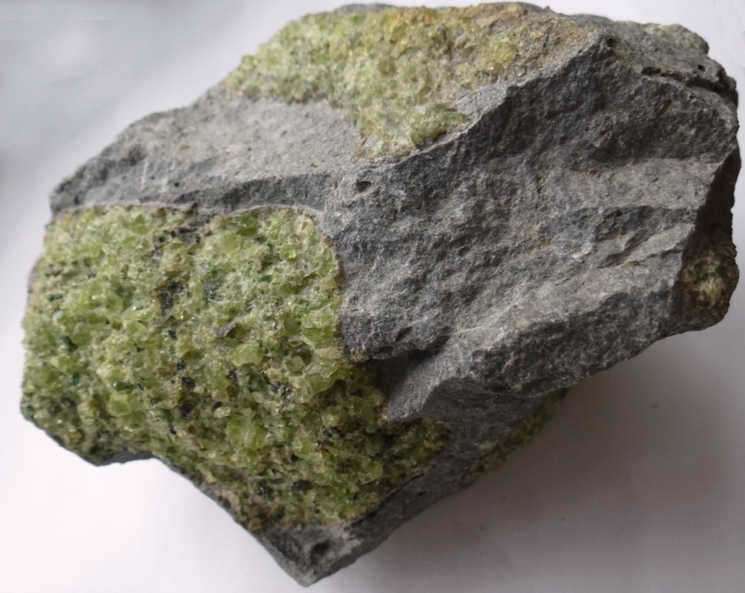
Olivine, a green-colored mineral, is found in this rock which originated in the mantle of the Earth. The rock was transported to the surface as a result of a volcanic eruption in the Canary Islands. Volcanic eruptions frequently offer insights into the internal composition of the Earth.
The Earth’s interior continues to release the heat that was generated during its formation as the core gradually cools and radioactive elements undergo decay. While this heat has the potential to escape to the surface, it is effectively insulated by the mantle rocks. The core’s emitted heat propels the movement of mantle material. As hot rocks ascend from the core, they eventually cool and descend back to it. This continuous circulation of mantle material, from the core to the surface and back, is known as convection.
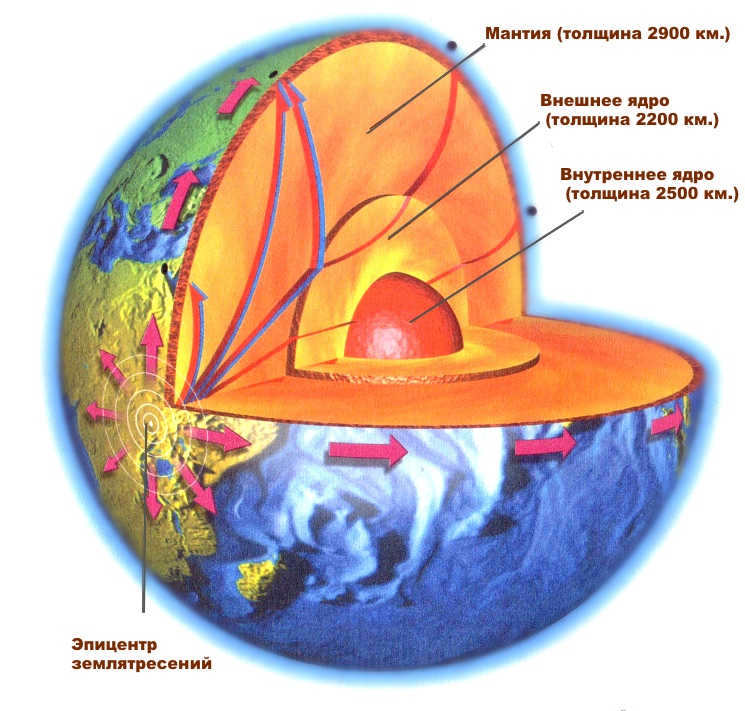
Geologists use seismic waves to study the internal structure of the Earth. These waves originate from the epicenter of an earthquake in East Africa and can be detected by seismic stations around the world. By analyzing the timing of these waves, scientists can reconstruct various features of the planet’s structure. Longitudinal waves, represented by the red lines in the diagram, are able to travel through the molten outer core. On the other hand, transverse waves, shown as blue lines, can only travel through the solid mantle and crust.
On the Earth’s surface, which is more susceptible to damage, earthquakes are caused by the movement of the mantle. Seismologists, experts who specialize in studying earthquakes, utilize a system of monitoring stations to observe and document seismic activity. By accurately measuring the arrival of seismic waves at various stations, advanced computers are able to create a detailed image of the internal workings of the Earth. In a similar vein, medical professionals employ X-rays to gain insight into the internal structures of our bodies.
Mantle dynamics and the formation of magma flows
Seismic sensors detect the upward movement of streams of molten material within the mantle, often resulting in increased volcanic activity. The propagation of seismic waves is slower within the hot, malleable substance, while they travel faster through the cold, solid rocks that submerge into the mantle at subduction zones, where oceanic crust slides beneath continental crust. Through analysis of seismic data, geologists have identified a “barrier” within the mantle at approximately 670 kilometers in depth, which is thought to be the accumulation point for sinking rocks.
These findings have prompted some geologists to suggest that the mantle consists of not just a single convective flow, but rather two layers of circulating rocks.
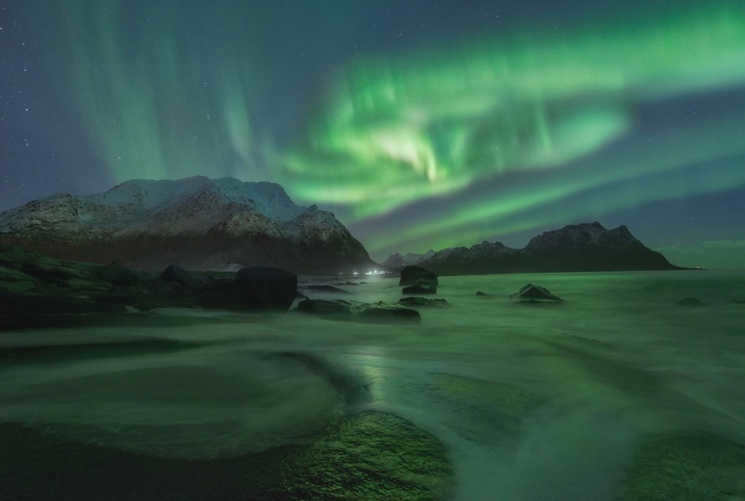
The phenomenon known as the northern lights takes place in the vicinity of the Earth’s magnetic poles (which are in close proximity to, but distinct from, the geographical poles) when charged particles from the sun collide with atoms and molecules in the Earth’s atmosphere. This vibrant display can be witnessed in both the northern and southern regions of the globe.
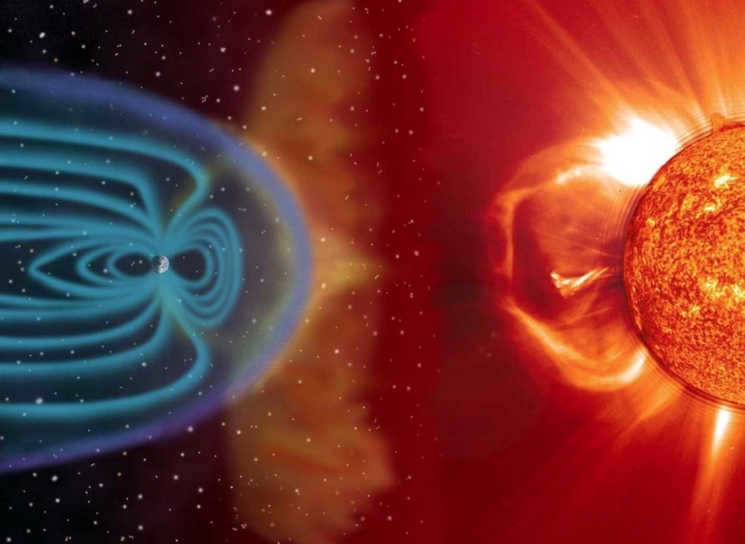

The Earth’s magnetic field creates a shield called the magnetosphere, which expands far out into space from the Earth’s surface. The solar wind, a flow of charged particles moving away from the Sun, exerts pressure on the magnetosphere, causing it to be dragged away from the Sun similar to the tail of a comet.
The structure of the Earth’s magnetic field can be compared to that of a massive bar magnet located within the Earth. In reality, magnetic field lines are formed by electric currents circulating in the molten outer core.
Alternatively, there is another theory to consider. These regions could potentially be the resting places of ancient oceanic floors. Once they descended to the depths of the upper mantle, the frigid oceanic crust became compacted into an incredibly dense rock layer, which eventually fractured at a depth of 670 km and continued to sink deeper. Presently, it is dispersing across the lower mantle floor. The core is gradually warming this compacted rock stratum, potentially leading to its eventual reemergence and the formation of a fresh oceanic crust.
The phenomenon of the Earth’s deceleration and the corresponding lengthening of the day
There is a lack of direct data regarding the material composition of the deep zones. Conclusions are derived from geophysical data, supplemented by experimental results and mathematical modeling. Valuable information is obtained from meteorites and fragments of upper mantle rocks that are brought to the surface by deep magmatic melts.
The overall chemical composition of the Earth closely resembles that of carbonaceous chondrites – meteorites that have a composition similar to the primary cosmic matter from which the Earth and other celestial bodies in the solar system formed. The Earth’s composition is primarily made up of five elements (in descending order of abundance): oxygen, iron, silicon, magnesium, and sulfur, which together account for 92% of its mass. The remaining 8% is comprised of various other elements.
However, the distribution of the listed elements in the geospheres of the Earth is not uniform – the composition of each shell significantly varies from the overall chemical composition of the planet. This discrepancy can be attributed to the differentiation processes that occurred during the formation and evolution of the Earth, which led to the separation of primary chondritic matter.
The core is where most of the iron is concentrated during the process of differentiation. This aligns with the density of core matter, the presence of a magnetic field, the differentiation of chondritic matter, and other evidence. Experiments conducted at ultrahigh pressures have demonstrated that pure iron has a density of approximately 11 g/cm 3 , which is higher than the actual density of the planet’s core. This suggests that there are lighter components present in the outer core. The most likely candidates for these components are hydrogen or sulfur. Calculations indicate that a mixture of 86% iron, 12% sulfur, and 2% nickel would have the same density as the outer core and would exist in a molten state under the pressure and temperature conditions found in this part of the planet. The inner core, on the other hand, is composed of nickelized iron, likely in a ratio of 80% Fe and 20% Ni, which matches the composition of iron meteorites.
There have been numerous proposals for describing the chemical makeup of the mantle so far (see Table). Despite their variations, all researchers agree that approximately 90% of the mantle is composed of silicon, magnesium, and divalent iron oxides, while another 5-10% is made up of calcium, aluminum, and sodium oxides. Therefore, these six oxides account for a staggering 98% of the mantle’s composition.
| Chemical composition of Earth’s mantle | Content in weight % | ||
| Pyrolite model | Lherzolite model | Chondrite model | |
| SiO2 | 45.22 | 45.3 | 48.1 |
| TiO2 | 0.7 | 0.2 | 0.4 |
| Al2O3 | 3.5 | 3.6 | 3.8 |
| FeO | 9.2 | 7.3 | 13.5 |
| MnO | 0.14 | 0.1 | 0.2 |
| MgO | 37.5 | 41.3 | 30.5 |
| CaO | 3.1 | 1.9 | 2.4 |
| Na2O | 0.6 | 0.2 | 0.9 |
| K2O | 0.13 | 0.1 | 0.2 |
According to the lherzolite model, the mantle is composed of 57% olivine, 27% pyroxenes, and 14% garnet up to a depth of 410 km. Its density is approximately 3.38 g/cm3. At the boundary of 410 km, olivine transitions to spinel and pyroxene transforms into garnet. Consequently, the lower mantle consists of a combination of garnet and spinel: 57% spinel + 39% garnet + 4% pyroxene. The transformation of minerals into denser forms at the 410 km boundary results in an increase in density to 3.66 g/cm3, which is reflected in an increase in the speed of seismic waves passing through this material.
The 670 km boundary marks the next phase transition. At this depth, the pressure plays a role in breaking down minerals found in the upper mantle and forming denser minerals. This reorganization of mineral associations leads to an increase in density at the 670 km boundary of about 3.99 g/cm3, which continues to increase as depth and pressure increase. As a result, seismic wave velocity experiences a sudden jump, followed by a gradual increase at the 2900 km boundary. It is believed that at the mantle-core boundary, silicate minerals undergo decomposition into metallic and non-metallic phases. This process of differentiation in mantle matter is accompanied by the growth of the planet’s metallic core and the release of thermal energy.
To summarize the information above, it is important to mention that mantle separation occurs due to the restructuring of mineral crystal structure without significant alterations in its chemical composition. Seismic boundaries at the interface are localized in regions where phase transformations occur and are connected to variations in material density.
As previously mentioned, the core/mantle interface is extremely distinct. At this point, there are significant changes in wave travel velocities, density, temperature, and other physical parameters. These drastic transformations cannot be explained solely by mineral crystal structure rearrangement and are undoubtedly linked to modifications in the chemical composition of the material.
For a more comprehensive understanding, additional information can be found regarding the composition of Earth’s crust, particularly the upper layers that are available for direct study.
The chemical makeup of the Earth’s crust varies from deeper layers of the Earth, primarily due to the higher concentration of lighter elements such as silicon and aluminum. However, it is important to note that the aforementioned data on the average composition of the Earth’s crust only represents the overall geochemical characteristics of this particular layer. Within the Earth’s crust, there are significant differences in composition between oceanic and continental crust types. The oceanic crust is formed by magma derived from the mantle, which results in a higher content of iron, magnesium, and calcium compared to the continental crust. The average elemental composition of the Earth’s crust is as follows (according to Vinogradov).
The composition of the Earth’s mantle is unique and different from the crust that covers it. Geologists obtain data on the chemical composition of the mantle by analyzing deep igneous rocks that have been uplifted through powerful tectonic forces, carrying mantle material to the Earth’s surface. Examples of these rocks include dunites and peridotites found in mountain systems. Geological evidence confirms that rocks from the St. Paul Islands in the mid-Atlantic Ocean and fragments collected from the Indian Ocean Ridge by Soviet oceanographic expeditions also belong to mantle material. The mineralogical composition of the mantle undergoes significant changes from the upper layers to the base due to increasing pressure. The upper mantle consists mostly of silicate minerals like olivines, pyroxenes, and garnets that are stable under relatively low pressures. In contrast, the lower mantle consists of high-density minerals.
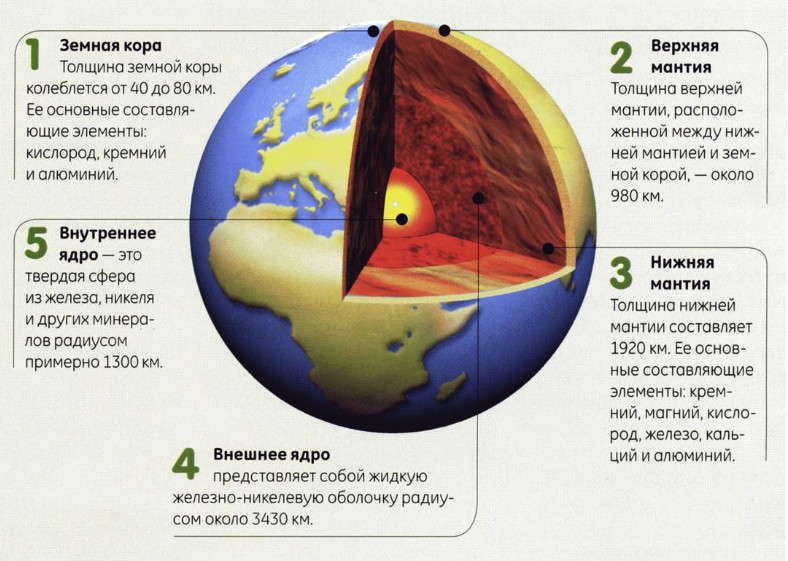
The main constituent of the mantle is typically silicon oxide in the form of silicates. However, under high pressures, silica can transform into a more compact polymorphic form known as stishovite. This particular mineral was discovered by the Soviet scientist Stishov and subsequently named after him. While regular quartz has a density of 2.533 g/cm3, stishovite, which is formed from quartz at a pressure of 150,000 bar, boasts a density of 4.25 g/cm3.
Furthermore, it is also plausible that other compounds in the lower mantle may undergo denser mineral transformations. Taking the aforementioned into consideration, it can be reasonably inferred that as pressure increases, the common ferruginous-magnesian silicates olivines and pyroxenes decompose into oxides, which individually possess a higher density compared to the silicates that remain stable in the upper mantle.
The upper mantle primarily consists of ferruginous-magnesian silicates, such as olivines and pyroxenes. Some aluminosilicates within this region may undergo transformations into denser minerals, like garnets. It is important to note that the upper mantle exhibits different properties and potentially different composition beneath continents and oceans. It is hypothesized that the mantle beneath continents is more differentiated and contains lower levels of SiO2 due to the concentration of this component in the aluminosilicate crust. Conversely, the mantle beneath oceans is less differentiated. Within the upper mantle, there may be occurrences of denser polymorphic variations of olivine, such as those with a spinel-like structure.
The transition zone of the mantle is characterized by a steady increase in seismic wave velocities as it goes deeper, indicating the presence of denser polymorphic forms of matter. It is believed that FeO, MgO, GaO, and SiO2 oxides are present in the form of wustite, periclase, lime, and stishovite. The concentration of these oxides increases with depth, while the amount of typical silicates decreases and becomes negligible below 1000 km.
The lower mantle, found at depths between 1000 and 2900 km, is predominantly composed of dense mineral varieties such as oxides, which is evident from its high density ranging from 4.08 to 5.7 g/cm3. Under increased pressure, these dense oxides are further compressed, thereby increasing their density. It is also likely that the lower mantle has an increasing iron content.
The composition and physical nature of Earth’s core is a fascinating and enigmatic subject in the fields of geophysics and geochemistry. Recently, there has been some progress in understanding this mysterious phenomenon.
Located deeper than 2900 km in the central region of our planet, the Earth’s core consists of a larger outer core and a smaller inner core. Based on seismic data, it is believed that the outer core exhibits fluid properties and does not transmit transverse seismic waves. The absence of cohesive forces between the core and the lower mantle, the behavior of tides in the mantle and crust, the distinctive movement of Earth’s rotation axis in space, and the characteristics of seismic waves beyond 2900 km all suggest that the Earth’s outer core is in a liquid state.
In 1958, A. Ridgwood made the admission that the Earth’s core contains silicon as a light element. He argued that elemental silicon is present in the metallic phase of some reduced chondritic meteorites (enstatite) in small amounts, around a few weight percent. However, there are no other supporting arguments for the existence of silicon in the Earth’s core.
The presence of sulfur in the Earth’s core can be inferred from a comparison of its distribution in chondritic meteorites and the Earth’s mantle. When comparing the elemental atomic ratios of certain volatile elements in the mixture of crust and mantle to those in chondrites, there is a significant lack of sulfur. The concentration of sulfur in the mantle and crust is three orders of magnitude lower than in the average material of the solar system, which is represented by chondrites.
The idea that sulfur may have been lost during the early stages of Earth’s formation due to high temperatures is rejected. This is because there are other elements, such as H2O, which are more volatile than sulfur and would have been lost to a greater extent. Furthermore, as the solar gas cools down, sulfur chemically combines with iron and no longer behaves as a volatile element.
Because of this, it is highly possible that substantial amounts of sulfur are entering the core of the Earth. It is worth mentioning that, under similar conditions, the Fe-FeS system has a much lower melting point compared to pure iron or mantle silicate. Therefore, at a pressure of 60 kbar, the melting point of the Fe-FeS system (eutectic) is 990° C, while pure iron has a melting point of 1610°, and mantle pyrolite has a melting point of 1310. As a result, as the temperature increases within the originally homogenous Earth, the sulfur-enriched iron melt will be the first to form due to its low viscosity and high density. It will easily flow towards the central regions of the planet, creating an iron-sulfur core. Consequently, the presence of sulfur in the iron-nickel medium acts as a flux, lowering the overall melting point. The hypothesis that significant amounts of sulfur exist in the Earth’s core is highly appealing and does not contradict any known data in the fields of geochemistry and cosmochemistry.
Therefore, contemporary theories regarding the composition of our planet’s interior align with a chemically distinct structure, which is divided into two distinct parts: a robust, solid mantle composed of silicates and oxides, and a primarily liquid metallic core. The Earth’s crust, on the other hand, represents the lightest uppermost solid layer, comprised of aluminosilicates and possessing a highly intricate structure.
Summarizing the aforementioned information, the following conclusions can be drawn:
- The Earth exhibits a stratified, zonal configuration consisting of a solid silicate-oxide mantle that accounts for two-thirds of its composition, and a liquid metallic core that makes up one-third.
- Based on the fundamental characteristics of the Earth, it can be inferred that the core exists in a liquid state and that only iron, among the most prevalent metals, combined with trace amounts of certain lighter elements (most likely sulfur), is capable of exhibiting these properties.
- The primary objective of any cosmogonic theory regarding the formation of the Earth is to provide an explanation for the fundamental characteristics of its internal nature and composition.
- The Earth’s crust is primarily composed of a small number of compounds: silicon oxide, aluminum oxide, and calcium oxide.
Earth’s Crust Composition
The compound with the third highest abundance in the Earth’s crust is calcium oxide (CaO). It makes up approximately 6.41% of the continental crust and around 12.3% of the oceanic crust.
Other commonly found compounds include magnesium oxides (4.6%), iron oxides (6.71%), sodium oxides (3.07%), potassium oxides (1.81%), titanium dioxide (0.72%), and phosphorus oxides (0.13%).
When considering the composition of the Earth’s crust by element, the proportions are as follows:
- Oxygen 46%
- Silicon 28%
- Aluminum 8.3%
- Iron 5.6%
- Calcium 4.2%
- Sodium 2.5%
- Magnesium 2.4%
- Potassium 2.0%
- Titanium 0.61%
- Other elements 0.39%
What makes our planet unique is the presence of two types of crust: continental and oceanic. In contrast, other Earth-like planets such as Venus and Mars have homogeneous planetary crusts.
Structure of Planets
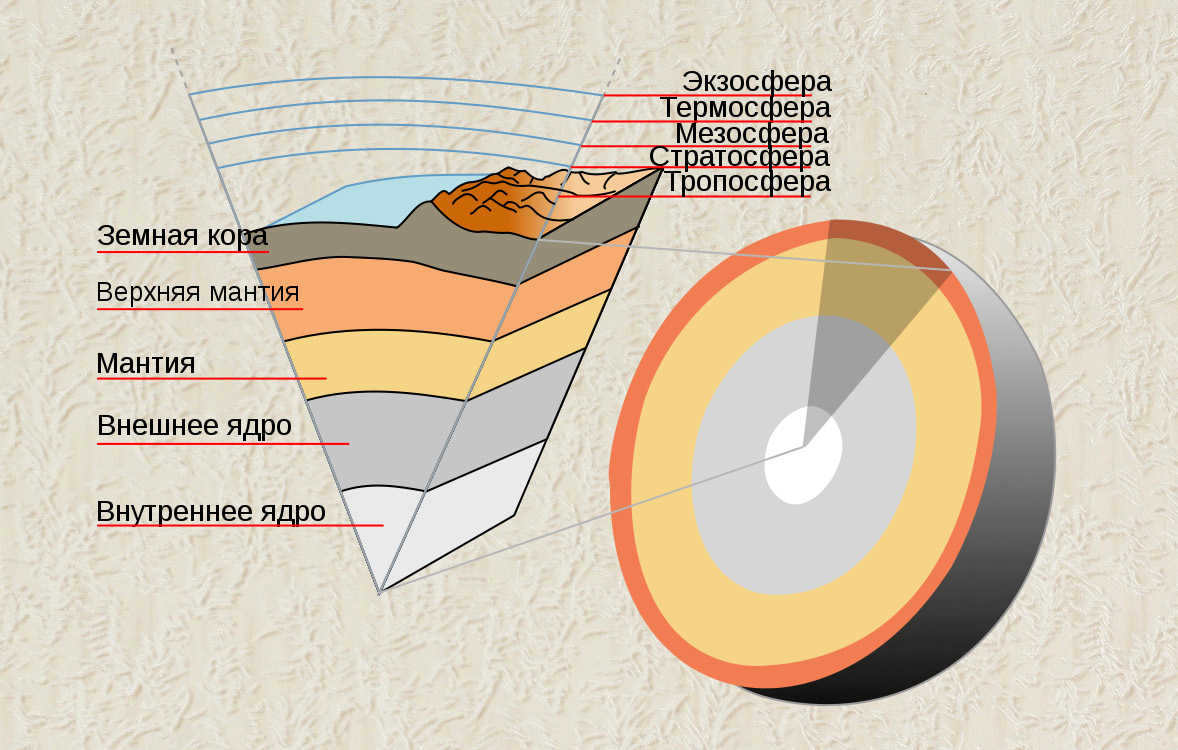
However, the core and mantle are the main components of the Earth’s mass, with the crust being just a small fraction. The estimated mass of the Earth’s crust is approximately 2.8×10 19 tons, with 21% being oceanic crust and 79% being continental crust. In terms of the Earth’s total mass, the crust accounts for only 0.473%.
Age of oceanic crust. The freshest regions are depicted in crimson, while the eldest ones are represented in azure.
The chemical composition of the mantle and the core greatly differs from that of the Earth’s crust.
Oxygen predominates in the Earth’s crust. What is the configuration of the planet’s mantle and core?
The composition of the mantle
- Oxygen: 44.8%
- Silicon: 21.5%
- Magnesium: 22.8%
- Iron: 5.8%
- Aluminum: 2.2%
- Calcium: 2.3%
- Sodium: 0.3%
- Potassium: 0.03%
The mantle of the Earth is made up of various elements, with oxygen being the most abundant at 44.8%. Silicon, magnesium, and iron are also present in significant amounts at 21.5%, 22.8%, and 5.8% respectively. Other elements such as aluminum, calcium, sodium, and potassium make up smaller percentages of the mantle’s composition.
The chemical composition of the mantle is similar to that of the Earth’s crust, which is the outermost layer of the planet. This similarity can be attributed to the fact that the Earth’s crust is essentially the frozen surface of the planet, formed over millions of years.
On the other hand, the core of the Earth is primarily composed of an iron-nickel alloy with traces of other siderophilic elements. The exact size of the core is still a subject of debate among scientists, but it is generally estimated to have a diameter of around 7,000 km.
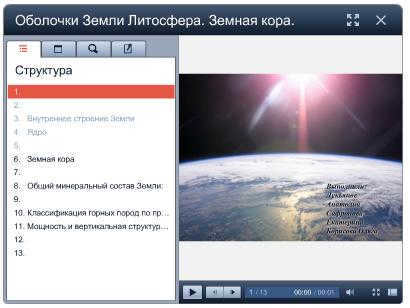
The Earth’s core is currently in a specific state, which is similar to the composition of other planets in the Earth group, such as Venus or Mars (see Figure 1).
Generally, elements like iron, oxygen, silicon, magnesium, and nickel are dominant. Light elements have a small presence. The average density of Earth’s matter is 5.5 g/cm3.
There is limited reliable information available on the internal structure of the Earth. Refer to Figure 2. It illustrates the internal structure of the Earth. The Earth is composed of the crust, mantle, and core.
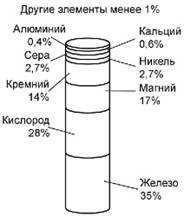
Figure 1. The Earth’s core: its current state and chemical composition
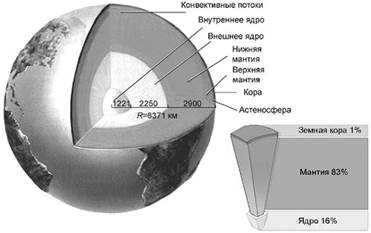
Earth’s Core
The Earth’s core is situated at the center of our planet (refer to Figure 3), with a radius of approximately 3,500 km. It has a temperature of 10,000 K, which is higher than the temperature of the Sun’s outer layers, and a density of 13 g/cm3 (for comparison, water has a density of 1 g/cm3). It is believed that the core is primarily composed of iron and nickel alloys.
The outer core, which has a radius of 2,200 km, is more massive than the inner core and exists in a liquid (molten) state. The inner core, on the other hand, experiences immense pressure and consists of solid substances.
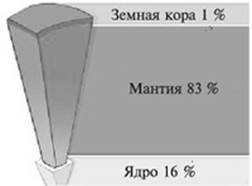
Figure 3. The arrangement of the Earth’s layers: core, mantle, and crust
The Mantle
The Earth’s Crust
The Earth’s crust, which is the outermost layer of the lithosphere (refer to Figure 3), has a density that is approximately half of the Earth’s average density, which is 3 g/cm3.
The crust is separated from the mantle by the Mohorovicich boundary, also known as the Moho boundary. This boundary is characterized by a sudden increase in seismic wave velocities and was discovered in 1909 by Croatian scientist Andrej Mohorovičić (1857-1936).
Since the processes occurring in the uppermost part of the mantle have an impact on the movements of material in the Earth’s crust, they are collectively referred to as the lithosphere, or the rocky shell. The thickness of the lithosphere can vary from 50 to 200 km.
Underneath the lithosphere lies the asthenosphere – a shell that is not as rigid or viscous, but rather more malleable, with a temperature of 1200 °C. It has the ability to breach the Moho boundary and infiltrate the Earth’s crust. The asthenosphere serves as the origin of volcanic activity. It holds reservoirs of molten magma that infiltrate the Earth’s crust or erupt onto the Earth’s surface.
Structure and Composition of the Earth’s Crust
The Earth’s crust, in comparison to the mantle and core, is an incredibly thin, rigid, and delicate layer. It is made up of lighter materials and consists of approximately 90 naturally occurring chemical elements. However, these elements are not evenly distributed throughout the Earth’s crust. The mass of the Earth’s crust is primarily composed of seven elements: oxygen, aluminum, iron, calcium, sodium, potassium, and magnesium, which make up 98% of its total mass (refer to Figure 5).
Different combinations of these chemical elements give rise to a wide variety of rocks and minerals, some of which date back at least 4.5 billion years, making them the oldest known formations.
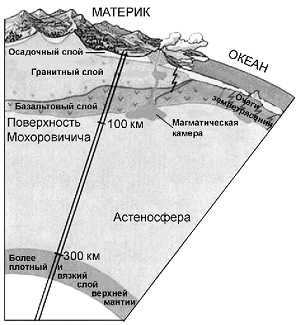
Figure 4: The Earth’s crust structure
A mineral is a natural body that is relatively homogeneous in composition and properties. It can be formed in the depths or on the surface of the lithosphere. Examples of minerals include diamond, quartz, gypsum, talc, and more. Appendix 2 contains detailed information about the physical properties of different minerals. Figure 6 shows the composition of minerals found on Earth.
Figure 6: Overall mineral composition of the Earth
Rocks are formed by minerals. They can consist of a single mineral or multiple minerals.
There are two main types of sedimentary rocks: organogenic and non-organogenic (clastic and chemogenic).
Organogenic rocks form through the accumulation of animal and plant remains.
Clastic rocks, on the other hand, are created through weathering or the fragmentation of previous rocks by water, ice, or wind (Table 1).
Table 1: Clastic rocks categorized by fragment size
Chemogenic rocks, on the other hand, form through the deposition of dissolved substances from seas and lakes.
Magmatic rocks (Fig. 7), such as granite and basalt, are formed from magma within the Earth’s crust.
When subjected to high pressure and temperatures at great depths, sedimentary and igneous rocks undergo significant changes and transform into metamorphic rocks. Marble is formed from limestone, while quartzite is formed from quartz sandstone.
The sedimentary layer (see Fig. 8) consists primarily of sedimentary rocks. Clays and shales are the dominant types, but sandy, carbonate, and volcanogenic rocks are also widely present. This layer contains deposits of organic minerals such as coal, gas, and oil. Coal, for example, is the result of plant transformations from ancient times. The thickness of the sedimentary layer can vary greatly, ranging from its absence in some land areas to 20-25 km in deep trenches.
Figure 7. The classification of rocks based on their origin
The Earth’s crust varies in thickness and vertical structure. There are various types of the Earth’s crust (Fig. 8). The most basic classification distinguishes between the continental and oceanic crust.
The continental and oceanic crust differ in terms of thickness. The maximum thickness of the Earth’s crust is observed under mountain systems, reaching about 70 kilometers. Under the plains, the thickness of the Earth’s crust is around 30-40 kilometers, while under the oceans it is the thinnest, measuring only 5-10 kilometers.
Figure 8. Earth’s crust variations: 1 – water; 2- layer of sedimentary rocks; 3 – intermingling of sedimentary rocks and basalts; 4 – basalts and crystalline ultrabasic rocks; 5 – granite-metamorphic layer; 6 – granulite-basite layer; 7 – normal mantle; 8 – unconsolidated mantle.
The distinction between the continental and oceanic crust lies in the rock composition, as evidenced by the absence of a granite layer in the oceanic crust. Moreover, the basaltic layer of the oceanic crust has its own unique characteristics, with rock compositions differing from those found in the continental crust.
The land-ocean boundary (zero mark) does not indicate the transition from continental crust to oceanic crust. This transition actually takes place in the ocean at a depth of approximately 2450 meters.
Figure 9. Structure of the Earth’s continental and oceanic crust
The suboceanic crust is situated in continental slopes and foothills and can be found in marginal and Mediterranean seas. It represents a continental crust that is approximately 15-20 km thick.
The subcontinental crust, on the other hand, is located in volcanic island arcs, for instance.
We obtain information about the deep structure of the Earth’s crust through seismic sounding, which involves studying the velocity of seismic waves. The Kola ultra-deep well, for example, provided the first opportunity to examine rock samples from a depth of over 12 km, revealing many unexpected discoveries.
The temperature of the Earth’s crust changes as we go deeper. The near-surface layer of the crust is influenced by solar heat and experiences seasonal temperature variations. This layer, known as the heliometric layer (from Greek helio – Sun), has an average thickness of about 30 meters.
There is a layer below that is even thinner and is known for having a consistent temperature that matches the average yearly temperature of the observation location. In areas with a continental climate, this layer becomes thicker.
Further down in the Earth’s crust, there is a geothermal layer that is influenced by the Earth’s internal heat. As we go deeper, the temperature of this layer increases.
The rise in temperature primarily occurs because of the breakdown of radioactive elements found in rocks, particularly radium and uranium.
The geothermal gradient refers to the increase in rock temperature as depth increases. It can vary significantly, ranging from 0.1 to 0.01 °C/m, and is influenced by factors such as rock composition, environmental conditions, and other variables. In oceanic regions, the temperature rises more rapidly with depth compared to continental areas. On average, the temperature increases by 3 °C for every 100 m of depth.
The reciprocal of the geothermal gradient is known as the geothermal step, which is measured in m/°C.
The Earth’s crust’s heat serves as a valuable energy source.
The Earth’s interior, which encompasses the part of the crust accessible for geological study, must be protected and utilized responsibly.
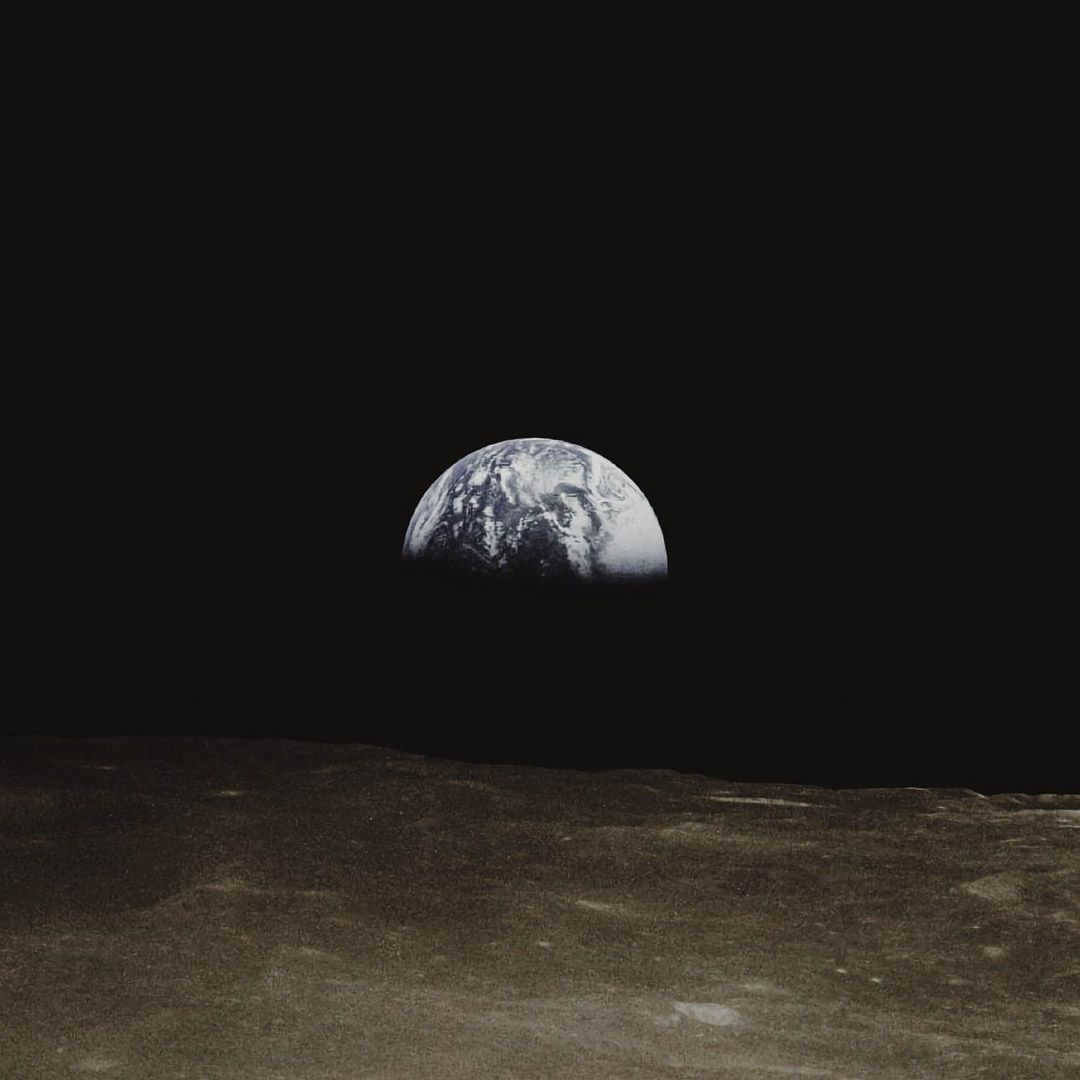
It is quite fascinating that the Earth’s core is made up of an iron-nickel mixture that is slightly hotter than the Sun and incredibly solid. The composition and high temperature of the core are well-established facts, but what may seem peculiar is the core’s ability to maintain its solid state despite its intense heat. Even though the core is located 2900 kilometers beneath the Earth’s surface and remains unexplored by mankind, scientists possess a comprehensive understanding of its composition and other characteristics. As a result, they can provide a thorough explanation as to why the iron-nickel alloy within the depths of our planet does not liquefy. Interestingly enough, the reasons behind this phenomenon are surprisingly straightforward, and many individuals might find themselves astonished by their simplicity.
What makes up the layers of the Earth
From our early education, we are aware that the Earth is composed of three primary layers: the crust, the mantle, and the core. The thickness of the Earth’s crust varies across different regions – it can reach up to 100 kilometers in mountainous areas, while at the ocean floor it measures approximately 6-7 kilometers. Directly beneath the Earth’s crust lies the mantle, an extensive layer spanning 2,900 kilometers. This mantle accounts for a significant portion of the Earth’s total volume (83%) and nearly 70% of its mass. Beyond the mantle lies the core, which can be further categorized into two parts: the outer core, with a diameter of 2,200 kilometers, and the inner core, with a diameter of 1,300 kilometers. While the outer core remains in a liquid state, it is the solid inner core that captures our curiosity in the context of this article.
How do scientists determine the Earth’s structure?
Throughout the history of scientific exploration, scientists have only been able to obtain samples of the Earth’s crust. For decades, the Kola ultra-deep well, reaching a depth of 12,000 meters, has held the record as the deepest hole on Earth. However, in 2023, a breakthrough occurred: a hole was created that allowed scientists to delve further into the mantle and collect samples for analysis. This remarkable achievement took place in an area where the Earth’s crust is less than 1,000 meters thick, and researchers were able to successfully drill through it.
The Atlantis massif served as the location for this groundbreaking drilling project, reaching depths previously unexplored.
Individuals who faced challenges in drilling a 1000-meter well can only dream of overcoming the several thousand kilometers thick mantle. However, despite these obstacles, scientists possess extensive knowledge about the deep inner workings of the Earth, even able to provide a detailed account of the composition of the Earth’s core. This understanding is made possible through the examination of seismic waves originating from deep-seated earthquakes. The propagation speed of these waves varies in each layer, contingent upon its structure and composition.
Reasons Behind the Solid State of the Earth’s Core
After performing extensive calculations, scientists have discovered that the Earth’s inner core maintains a temperature range of 5,700-6,200 Kelvin. Surprisingly, this temperature closely aligns with the average temperature of the Sun’s surface and even surpasses it in some instances. While the majority of the Sun reaches temperatures of 5,772 Kelvin, there are certain regions, known as dark spots, where the plasma temperature drops to around 4,000 Kelvin.
Given that the Earth’s inner core is composed of an alloy consisting of iron and nickel, it is perplexing that the central region of our planet remains solid. Iron and nickel, as metals, typically undergo melting at temperatures of approximately 1500 degrees Celsius, leading one to expect that the core would be in a liquid state.
It is worth noting that the Earth’s core possesses a higher temperature compared to sunspots.
The explanation for the solid state of the Earth’s core is quite straightforward. It is due to the immense pressure exerted on the central region of the planet by the outer core, mantle, and crust. At the boundary of the inner core, the pressure reaches approximately 350 gigapascals, which is equivalent to 3 million times the atmospheric pressure at sea level. This intense pressure causes the atoms to be tightly held within the crystal lattice structure of the iron-nickel alloy, resulting in its hardness.
The solid inner core of the Earth has recently come to a near-complete halt in its rotation. Let us explore the implications of this event for the human race.
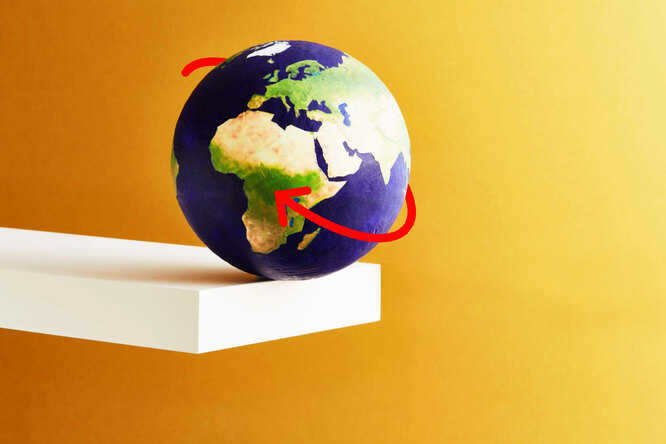
A team of geologists from Peking University conducted a study on the state of the Earth’s core. The findings of their research have been published in the scientific journal Nature Geoscience.
What is the main focus of the research?
By analyzing seismic data from long-term observations in Alaska, Kazakhstan, Indonesia, and the Kuril Islands, scientists have deduced that the Earth’s core, which typically spins on its axis, has nearly halted its rotation. It is highly probable that it will eventually resume rotating, albeit in the opposite direction.
Scientific evidence confirms that the core’s rotation direction and speed can undergo periodic changes, usually occurring approximately every 70 years.
In school, we were all taught about the Earth’s structure. Although we often feel stable on our feet, our planet is not stationary on the inside. The different layers of the Earth – the core (composed of a liquid outer layer and a solid inner layer), the mantle, and even the Earth’s crust – are constantly in motion, each at their own speed and direction.
What we understand about the inner core of the Earth:
- The inner core is of immense size, measuring 2,440 km in diameter, which is only 1,000 km smaller than the Moon. Furthermore, it is gradually growing in size as the liquid core outside cools and solidifies;
- The inner core is extremely hot, with a core temperature reaching 5,400 degrees Celsius;
- Additionally, the inner core is composed of metallic elements, specifically iron and nickel.
What is the significance of this study?
Chinese scientists believe that altering the velocity and trajectory of the Earth’s inner core could have implications for humans.
The shifting of the core has the potential to redistribute heat zones across the planet, resulting in changes to the length of the day and the stability of the Earth’s magnetic field. Our protection from the Sun may also be impacted by these changes. However, further research is needed before any definitive conclusions can be drawn.
Men Today is an online publication that focuses on men’s fashion and lifestyle. It was founded by Anton Leonidovich Ivanov and is based in Moscow, Russia.
The headquarters of the LLC “Fashion Press” is located at Bolshoi Savvinsky per. 12, str. 6, floor 3, room II. The editorial office, which can be contacted via [email protected] or +7 (495) 252-09-99, is also located at the same address.
Men Today is intended for readers aged 16 and above. It is registered with the Federal Service for Supervision in the Sphere of Communications, Information Technologies and Mass Media, with registration number FS77-84122. The registration was granted on November 09, 2022.





